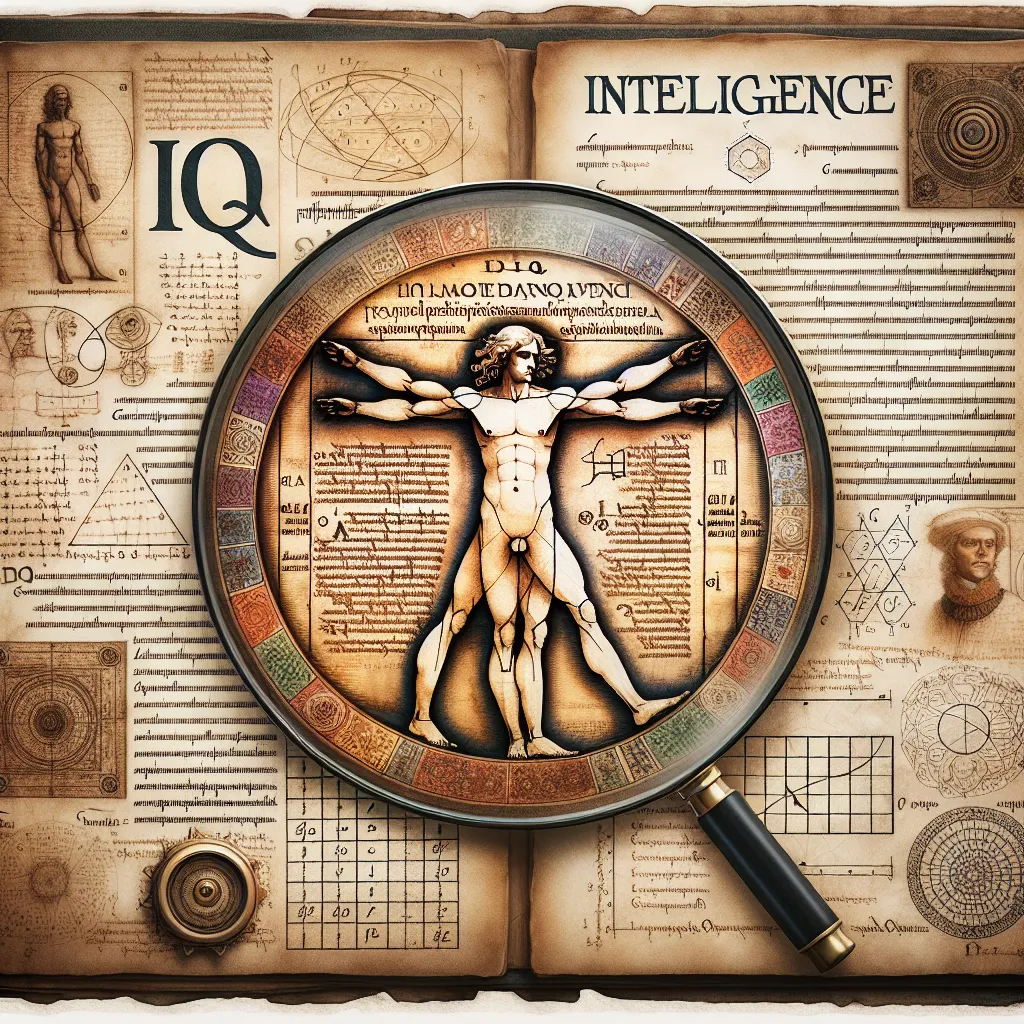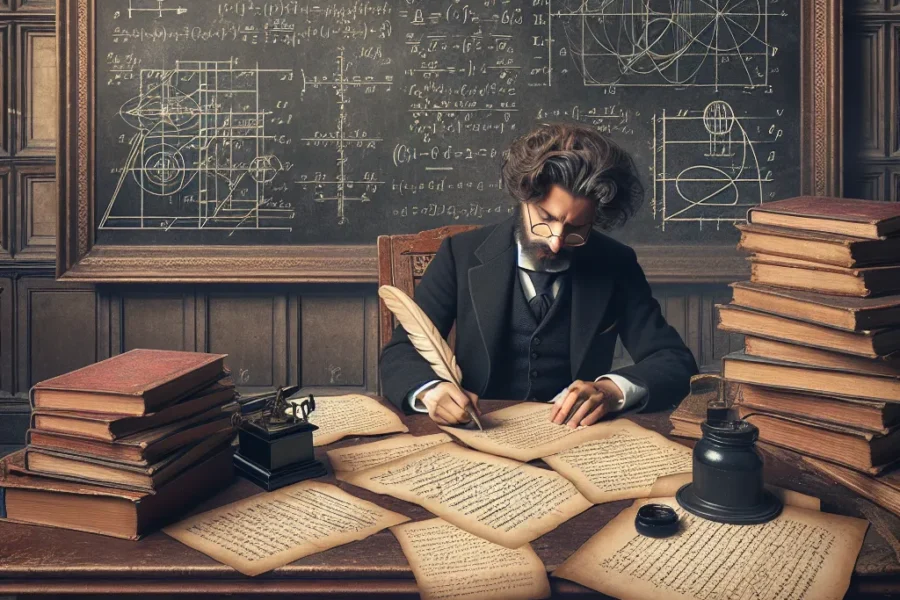Leonardo da Vinci, the quintessential Renaissance man, continues to captivate the world with his boundless curiosity, extraordinary talent, and ground-breaking inventions. From the enigmatic smile of the Mona Lisa to the visionary designs of aerial screw concepts that predated helicopters, da Vinci’s genius seems almost otherworldly. A question that often arises in discussions about his brilliance is: “What was Leonardo da Vinci’s IQ score?”
If you are looking for legitimate IQ Tests which pass the entry bar for Mensa, see our IQ Tests.
First and foremost, it’s essential to recognize that modern IQ tests, as we understand them today, did not exist during Leonardo da Vinci’s time. The concept of measuring intelligence quotient (IQ) was developed in the early 20th century, long after da Vinci had passed away. This makes it inherently impossible to ascribe a precise IQ score to da Vinci with any scientific accuracy. However, numerous scholars and enthusiasts have often speculated on what his IQ might have been based on his accomplishments, cognitive abilities, and creative genius.
Da Vinci was born in 1452 in the small town of Vinci, Italy. Even as a child, he exhibited exceptional intelligence and a keen observational skill, analyzing the world around him with an unparalleled depth. His notebooks, filled with intricate drawings, scientific diagrams, and mirrored handwriting, reveal a mind that was always at work, always questioning, and always seeking to push the boundaries of human knowledge.
To approximate da Vinci’s IQ, some historians have drawn comparisons with other renowned geniuses whose IQ scores have been more definitively estimated. For instance, Albert Einstein, whose theoretical contributions revolutionized physics, is often cited with an IQ between 160 and 180. Given da Vinci’s equally profound impact on multiple fields, from art to engineering to anatomy, it is plausible that his IQ would be in a similar range, if not higher.
Further evidence supporting the notion of da Vinci’s extraordinary cognitive abilities can be found in his varied achievements. He excelled in a multitude of disciplines:
1. **Art**: Da Vinci created some of the most iconic artworks in history. “The Last Supper” and “Mona Lisa” are not merely masterpieces of technical skill but also of psychological depth and pioneering techniques in perspective and composition.
2. **Science and Engineering**: His notebooks contain designs for inventions that were centuries ahead of their time, such as flying machines, armored vehicles, and hydraulic pumps. His detailed anatomical studies revealed insights into the human body that formed the foundation of modern biology and medicine.
3. **Mathematics**: Da Vinci’s application of mathematics to art and science was revolutionary. He explored geometry’s role in optics and perspective, making significant strides in understanding how we perceive and interact with the world.
Speculating on Leonardo da Vinci’s IQ also invites us to consider the nature of intelligence itself. IQ tests typically measure a range of cognitive abilities, including logical reasoning, mathematical skill, spatial understanding, and verbal acuity. Da Vinci was proficient in all these areas, making him a polymath in the truest sense of the word. His ability to seamlessly integrate knowledge from various domains and apply it innovatively underscores a form of intelligence that transcends conventional metrics.
One of da Vinci’s most remarkable traits was his relentless curiosity and insatiable desire to learn. He was a voracious reader, an acute observer of nature, and a relentless experimenter. His method of studying by making meticulous drawings and notes was ahead of his time and continues to inspire scientists and artists alike. His intellectual curiosity was not confined by the knowledge of his era, but rather propelled him to explore beyond accepted doctrines and embrace empirical evidence, a hallmark of scientific inquiry that would flourish in the centuries following his life.
Additionally, da Vinci’s ability to think abstractly and his innovative vision further reflect an intelligence that would likely score exceptionally high on modern IQ assessments. His conceptualization of the first helicopter, the Architonnerre (a type of giant crossbow), and other military innovations show a mind that was constantly inventing and problem-solving.
Though we might never definitively quantify Leonardo da Vinci’s intelligence with an exact IQ score, his legacy allows us to appreciate a broader and perhaps more profound understanding of genius. His contributions have withstood the test of time, influencing countless generations and continuing to inspire awe and admiration.
Further consideration leads us to the realization that modern IQ tests might not fully capture the extent of da Vinci’s genius. Such tests are structured to measure certain types of cognitive function, but da Vinci’s intelligence was multidimensional, encompassing creative, innovative, and practical aspects that a single number could scarcely represent.
His visionary ideas in urban planning, for instance, including designs for ideal cities that incorporated functionality, beauty, and hygiene, highlight his far-reaching intellect. Da Vinci’s diverse projects display an uncanny ability to foresee and address societal needs, which goes beyond what is typically measured through standard intelligence tests.
Moreover, it’s essential to acknowledge that environments also shape intelligence. Da Vinci thrived in a period of dynamic cultural and intellectual change known as the Renaissance, a time when learning and exploration were ardently pursued. This environment, which celebrated rediscovery and innovation, may have been crucial in nurturing da Vinci’s talents, allowing him to push the limits of his own abilities and set new benchmarks for human achievement.
Another indicator of Leonardo da Vinci’s profound intelligence is his ability to teach and mentor others. While many of his students and contemporaries were remarkable in their own right, da Vinci’s capability to inspire, instruct, and elevate those around him signifies an intelligence that was not merely about individual brilliance but also about fostering growth in others. His contribution to guiding and shaping the Renaissance artistic and scientific community speaks volumes about his comprehensive understanding and wisdom.
Da Vinci’s ingenuity can also be underscored by examining his mental models. He was known to use analogical thinking profusely, drawing parallels between vastly different domains to gain insights and develop novel ideas. For example, his study of bird flight informed his designs for human flight. This seamless transfer of knowledge from one field to another was not just indicative of his vast understanding but also his ability to think laterally and make connections that others might not see.
While it remains speculative to assign a numerical IQ score to Leonardo da Vinci, reflections on his life and works undeniably highlight an exceptional intellectual prowess that went beyond standard measures of intelligence. His legacy is a testament to the expansive potential of the human mind and serves as an enduring reminder of the power of curiosity, creativity, and interdisciplinary thought.
Leonardo da Vinci continues to be a symbol of unbounded human potential – an individual whose intellectual and creative conquests spanned the entire gamut of human endeavor. His legacy is best captured not in an IQ score but in the lasting impact and continued reverence for his work and his insatiable quest for knowledge. His story encourages us to not just quantify intelligence but to celebrate and cultivate the diverse talents and curiosities that propel humanity forward.



Leave a Comment